 Mara Elephant Project kicked off 2019 with two notable illegal firearms recoveries and one arrest. MEP intelligence led to the recovery of both firearms at different ends of the Serengeti border area between Kenya and Tanzania. On January 19, 150 rounds of ammunition were recovered then the next day an AK47 and one suspect was arrested by the Tanzania National Parks Authority in the eastern extent of the ecosystem in the Loliondo area (pictured left). The second firearm was recovered two days later by the Kenya Police based on MEP intelligence near Lolgorian in the western extent of the ecosystem, but, unfortunately, the two suspects escaped. These are two less firearms in circulation which would have been used for poaching wildlife and causing insecurity in the surrounding region. In the first quarter, MEP rangers continued to have success in the field with operational partners Kenya Wildlife Service (KWS) with six suspects arrested, and 16 kg of ivory confiscated along with hippo and warthog teeth.
Mara Elephant Project kicked off 2019 with two notable illegal firearms recoveries and one arrest. MEP intelligence led to the recovery of both firearms at different ends of the Serengeti border area between Kenya and Tanzania. On January 19, 150 rounds of ammunition were recovered then the next day an AK47 and one suspect was arrested by the Tanzania National Parks Authority in the eastern extent of the ecosystem in the Loliondo area (pictured left). The second firearm was recovered two days later by the Kenya Police based on MEP intelligence near Lolgorian in the western extent of the ecosystem, but, unfortunately, the two suspects escaped. These are two less firearms in circulation which would have been used for poaching wildlife and causing insecurity in the surrounding region. In the first quarter, MEP rangers continued to have success in the field with operational partners Kenya Wildlife Service (KWS) with six suspects arrested, and 16 kg of ivory confiscated along with hippo and warthog teeth.
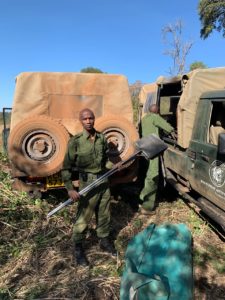
The headline for the month of March was most definitely the fire in the Mau Forest that started on March 18 and required a multi-unit approach to fight. The Sheldrick Wildlife Trust (SWT) Mau De-Snaring Unit was the first on the scene and later the MEP rapid response unit was brought in for reinforcement. The fires started in the area of Bosnia and MEP brought in over 50 fire beaters to combat the total eight fires that were burning in the Mau (pictured left).
They were spreading rapidly through the secondary forest which had been logged for cedar and more recently podocarpus trees causing a lot of dead wood, which added fuel to the fire. The deadwood and undergrowth meant the fires were concentrated and extremely hot. Once the fires spread to the bamboo part of the forest it sounded like gunshots because of the hollow bamboo shoots exploding when burnt. Kenya Forest Service sent in a team of 30 officers and by March 21 only two fires remained and by the end of the month heavy showers extinguished all fires completely.
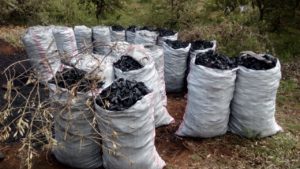
In addition to fighting forest fires in March, the SWT Mau De-Snaring Unit removed 55 snares in January of the total 89 removed in the first quarter along with eight spears used for targeting elephants. MEP rangers also destroyed five kilns, 20 sacks of charcoal (pictured right) and arrested seven suspects for illegal logging in the Mara. Finally, MEP rangers also provided ground support for KWS Vet Dr. Limo in four elephant treatments.
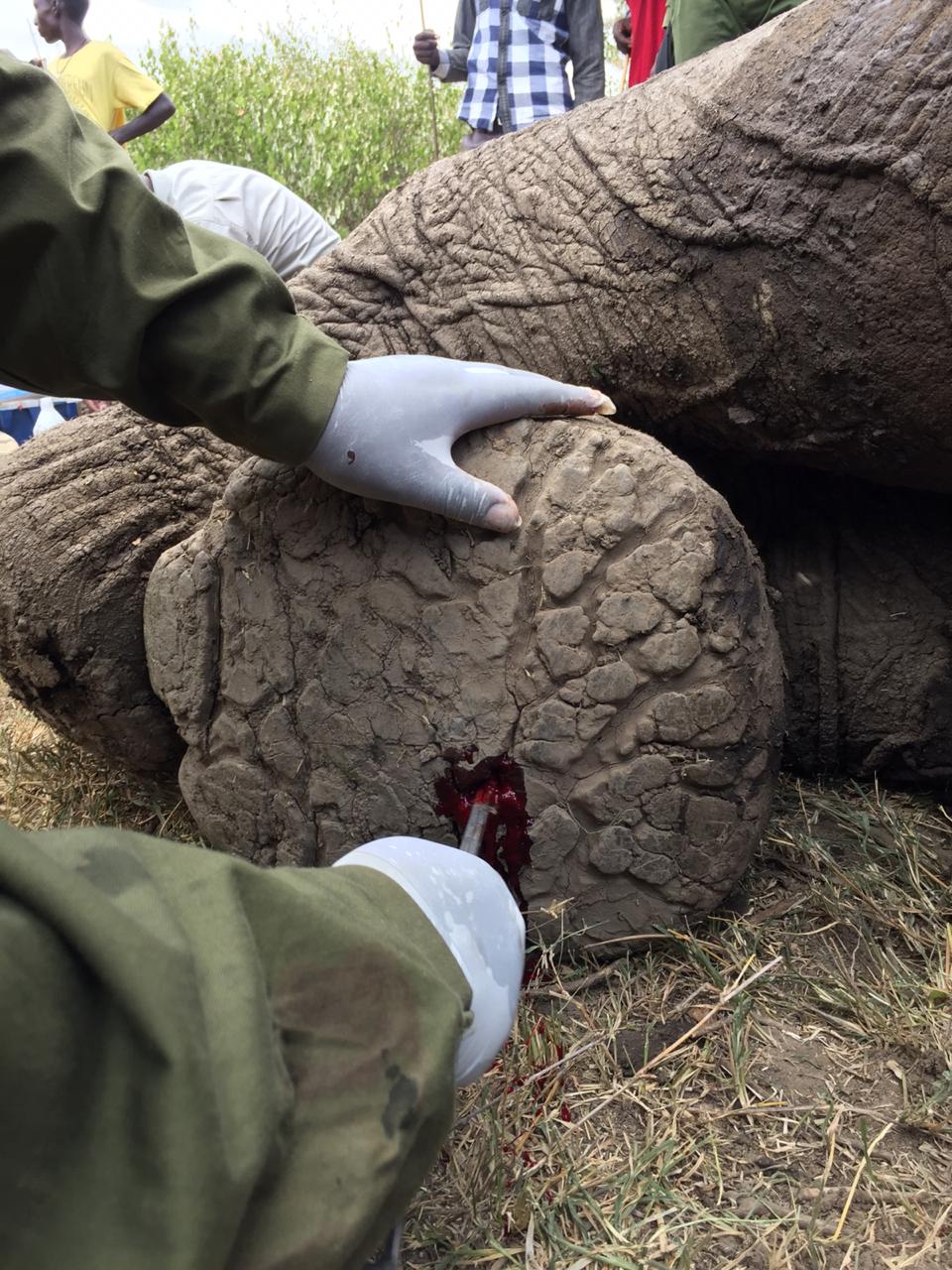
An elephant being treated by KWS Vet Dr. Limo in February after a piece from a fence got lodged in his foot.
All of this on top of responding to 38 incidents of human-elephant conflict, most using their vehicles, bright lights and flashbangs and for the first quarter of 2019 there were two elephant deaths as a result of human-elephant conflict. The helicopter was extremely helpful in January in the Mau Forest to move elephants away from the crop areas in the Olengurone area. I’m sorry to report that in mid-January the helicopter suffered an incident that will require several months to repair; however, we anticipate being back up and flying again by June 2019.
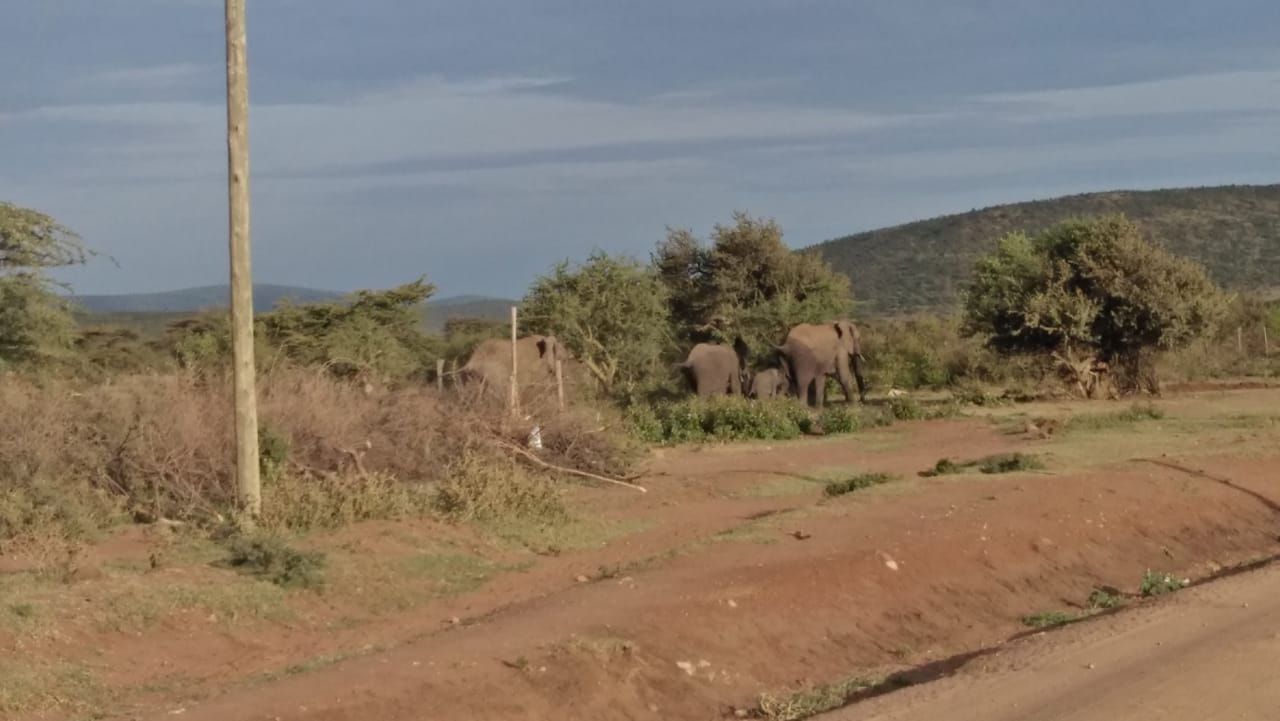
Elephants being moved out of a fenced area into a protected area by MEP rangers.
The MEP Board of Trustees held a meeting on February 12 and reviewed the fourth quarter of 2018 and discussed the upcoming objectives for 2019. We’re excited to announce that the board voted to increase all staff wages by 10% as per our annual increase policy which was implemented at inception to adjust to reflect inflation and also ensure that the job profession as a ranger continues to be competitive and appealing in terms of basic salary. We are also happy to report that we have implemented a new policy for staff, which is to provide school fee allowances for up to two children for each staff member. MEP rangers work tirelessly in their patrol units to protect elephants to conserve the greater Mara ecosystem, one of Kenya’s most important ecosystems and they are at the forefront of our anti-poaching operations and human-elephant conflict mitigation efforts. Ranger retention and morale are of the upmost importance to MEP which is why we introduced this program. MEP is looking for a patron for this initiative, which will cost the organization $15,000 a year to run. If you’re interested, please email me.

MEP Tracking Manager Wilson Sairowua visiting a school in the Mara.
We are finalizing our 2018 Annual Report which should be released in May. The annual report will show that in the last seven years (2011-2018), MEP has increased our presence on the ground, reduced poaching, expanded our partnership network, effectively used innovative techniques and technologies to mitigate conflict, increased our community activism and engagement and expanded our elephant research program. MEP’s goals in 2019 include focusing on the protection of elephants and the conservation of the Mara ecosystem by increasing our research efforts all while investing in the education of local communities who live alongside wildlife and the future generation of Kenyans who will inherit this complicated mission.
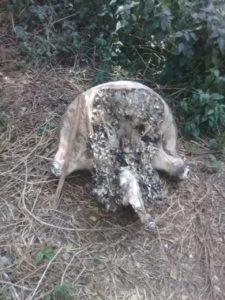
One of the main fundraising goals for 2019 is establishing a permanent ranger unit in the Loita Hills. This fits directly into the first quarter report because in February an elephant carcass was reported to MEP rangers and was around two months old with its tusks removed, cause of death: poaching (pictured left).

Illegal logging activity in the Loita area photographed from the MEP helicopter in October 2018.
Currently, MEP has been able to expand into the Loita area by re-deploying rangers from the core rapid response units away from conflict hotspots during the low conflict seasons and this response has already made an impact. In October 2018 our intelligence unit arrived in Mosiro and discovered an active poaching ring operating in the area. An elephant carcass estimated to be a month old was found without tusks. Additionally, the animals were all very skittish and though they found elephant tracks, there was no evidence of elephants stopping to eat or drink, meaning they were aware they were under threat. MEP CEO Marc Goss and Senior Warden James Ekiru deployed the helicopter to help find a reported large elephant herd and investigate the Loita area by air. What they found was very discouraging; lots of illegal logging was taking place in the forest, the community farms were encroaching on the forested land and they even found an active poachers camp. A herd of over 100 elephants was observed living in this portion of the forest, all of which would be at a high risk of poaching or being harmed while coming in contact with humans. In response, MEP deployed its rapid response team into this northern section of the Loita Forest to monitor the elephants, shutdown illegal logging sites, root our any poachers, and help mitigate human-elephant conflict and better relations for the bordering community. As a result, in October, four suspects were arrested for illegal logging with 500 posts confiscated. Though the rapid response unit made significant headway, without a permanent team in the Loita Forest it is very difficult to effectively provide elephants protection and gather information on the ever-changing situation.

The large herd of elephants spotted in October 2018 in Loita.
MEP needs support for two years to establish a permanent ranger unit for the Loita Hills at an operational cost of $52,000 a year plus a further $71,000 for ranger field equipment and a vehicle resulting in an overall cost over the two years of $174,500. An individual donor has already agreed to make a $50,000 contribution toward the establishment of this team in 2019. MEP also received support for $62,000 to cover the cost of a dedicated vehicle from the Elephant Crisis Fund, an initiative launched by Save the Elephants and the Wildlife Conservation Network, in partnership with the Leonardo DiCaprio Foundation; however, more is needed. Based on what we’ve just experienced with the establishment of a permanent Mau Forest unit, a two-year timeline is necessary to ensure that the proper training and equipment is established within the first six months of the team before an impact can really be made. This team would be established as soon as funding is secured and consist of seven rangers, a driver and two KWS rangers that are well-equipped and trained to start making an impact in this area. Elephants play a key role in structuring habitats and no habitats are more important to Kenya’s well-being than its forests, which often act as the water tower for key rivers and lakes in Kenya. MEP’s ability to protect elephants in the Loita Forest will directly help protect the forest and the communities living alongside.
 The second area where MEP needs to raise funds for 2019 is the helicopter. This vital tool covers every single aspect of our organization’s operations and supporting flying hours for the helicopter ensures we continue to operate the only helicopter dedicated to wildlife in the Mara. Since MEP has the only operating helicopter dedicated to wildlife in the Mara, this tool has become essential not only for us, but for our partners, like KWS. KWS Vet Dr. Limo from the Sheldrick Wildlife Trust Mara Mobile Vet Unit performs most elephant treatments in the Mara and MEP provides both aerial and ground support to Dr. Limo’s team ensuring the elephant treatment is safe for personnel and the animal being treated. Additionally, locating an injured elephant from the air improves response time to treat the injured elephant and can often spot an injury in otherwise impossible circumstances like thick vegetation. The MEP helicopter ensures that we are saving more elephants faster. The MEP helicopter flew 38.20 hours in 2018 in support of these operations.
The second area where MEP needs to raise funds for 2019 is the helicopter. This vital tool covers every single aspect of our organization’s operations and supporting flying hours for the helicopter ensures we continue to operate the only helicopter dedicated to wildlife in the Mara. Since MEP has the only operating helicopter dedicated to wildlife in the Mara, this tool has become essential not only for us, but for our partners, like KWS. KWS Vet Dr. Limo from the Sheldrick Wildlife Trust Mara Mobile Vet Unit performs most elephant treatments in the Mara and MEP provides both aerial and ground support to Dr. Limo’s team ensuring the elephant treatment is safe for personnel and the animal being treated. Additionally, locating an injured elephant from the air improves response time to treat the injured elephant and can often spot an injury in otherwise impossible circumstances like thick vegetation. The MEP helicopter ensures that we are saving more elephants faster. The MEP helicopter flew 38.20 hours in 2018 in support of these operations.
 Dr. Limo working on an elephant that had been moved to safety using the MEP helicopter.
Dr. Limo working on an elephant that had been moved to safety using the MEP helicopter.
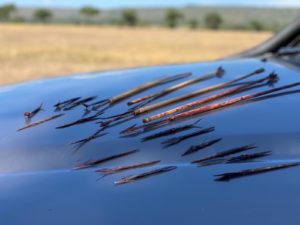 As an essential part of the HEC toolkit, the helicopter enables us to respond rapidly to human-elephant conflict. It works extremely well when used alongside our rangers on the ground, who are our first line of defense. It also has the advantage of increasing the rapid response time, when the terrain is difficult, and expanding our operational area thanks to the helicopter’s ability to traverse a large area in a short period of time. Since 2015, over 145 hours of the helicopter flying time has been used in mitigation efforts. In 2018, of the 201 human-elephant conflict incidents MEP responded to, we flew the helicopter 23.70 hours to mitigate HEC situations. One such incident in October found a herd of elephants trying to cross the Mara River into Mara North Conservancy as an angry mob was attacking them with spears and arrows. The helicopter was instrumental in protecting the herd from the crowd and guiding them to safety. We can confidently say that the helicopter directly saved this herd from being killed by the community. After safely bringing them back across the river the KWS veterinarian pulled 20 arrows out of three elephants (pictured right). In 2018, HEC elephant deaths remained steady at 12 despite the 201 HEC incidents we responded to and the helicopter played an essential part in keeping this number low.
As an essential part of the HEC toolkit, the helicopter enables us to respond rapidly to human-elephant conflict. It works extremely well when used alongside our rangers on the ground, who are our first line of defense. It also has the advantage of increasing the rapid response time, when the terrain is difficult, and expanding our operational area thanks to the helicopter’s ability to traverse a large area in a short period of time. Since 2015, over 145 hours of the helicopter flying time has been used in mitigation efforts. In 2018, of the 201 human-elephant conflict incidents MEP responded to, we flew the helicopter 23.70 hours to mitigate HEC situations. One such incident in October found a herd of elephants trying to cross the Mara River into Mara North Conservancy as an angry mob was attacking them with spears and arrows. The helicopter was instrumental in protecting the herd from the crowd and guiding them to safety. We can confidently say that the helicopter directly saved this herd from being killed by the community. After safely bringing them back across the river the KWS veterinarian pulled 20 arrows out of three elephants (pictured right). In 2018, HEC elephant deaths remained steady at 12 despite the 201 HEC incidents we responded to and the helicopter played an essential part in keeping this number low.
MEP’s helicopter is not only used for human-elephant conflict mitigation, but also for assistance with other wildlife living in the Mara. The helicopter has been used to gather information on the critically endangered mountain bongo antelope living in the Mau Forest, it’s been used to assist with treatments of lions, giraffes, buffalo and rhino as well as to investigate the cause of death of various other wildlife and to complete well-being checks in the endangered black rhino. The MEP helicopter flew 7.9 hours in support of other wildlife in 2018.
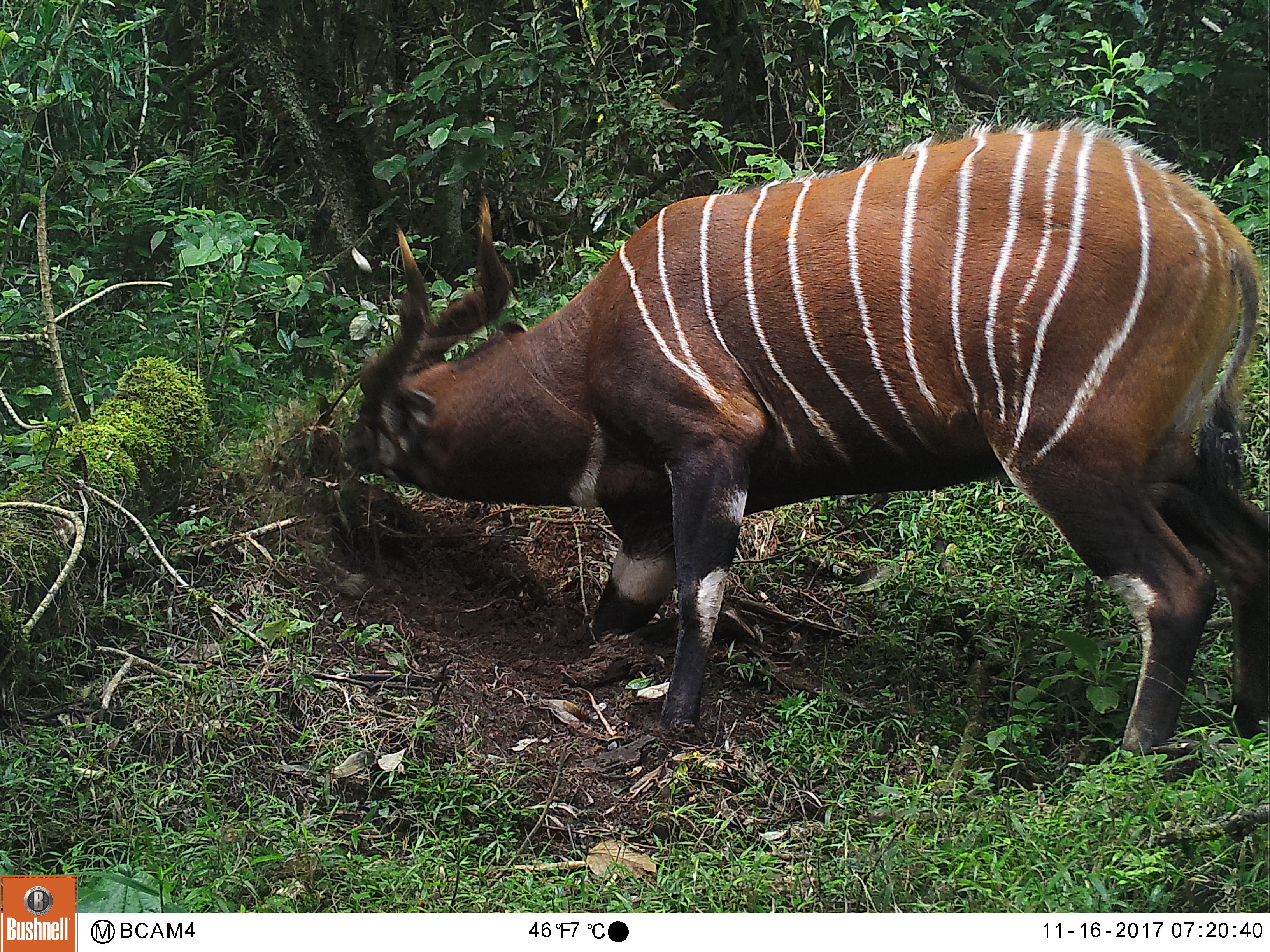
A photograph of an endangered mountain bongo antelope that was captured on a camera trap in 2017 by the Bongo Surveillance Project.
It is also an essential element to the MEP elephant collaring operations ensuring both our personnel and the elephant are safe while deploying the collar. MEP monitors elephants in real-time by deploying satellite-enabled GPS tracking collars onto elephants. Collared elephants provide data that is being used daily to mitigate human-elephant conflict, inform ranger deployment and anti-poaching work, and promote transboundary cooperation within the wider ecosystem. MEP has adopted the advanced EarthRanger tracking platform to collate and visualize the data streams from elephants. The software runs real-time monitoring algorithms that can detect when an elephant becomes immobile, breaches a geofence, or starts to move slowly that could indicate an injury or illness and which MEP reacts to at a moment’s notice. Using these tracking data, MEP generates monthly tracking reports and density and movement maps to better understand the patterns and behavior of these tracked animals. Each day coordinates are sent to ground patrols who use these to check on the elephants. Depending on the satellite image quality, it is possible to see settlements near the collared elephant. This information is used to anticipate possible human-elephant conflict incidents and intervene before they occur. Through the aerial monitoring program, we have identified the collared elephants represent between 400 and 600 elephants. The tracking collars, the monthly monitoring and the analytics and database system are critical components of MEP’s operations. The continued aerial monitoring of collared elephants is also critical for their well-being and in 2018, the helicopter flew 14.60 hours to monitor elephants.

Monitoring collared elephant Julia and her family herd from the air.
The MEP helicopter ensures that we are saving more elephants faster. The helicopter continues to be an invaluable tool in supporting ranger units on the ground and increasing our area of operation while decreasing our rapid response time. In 2018, the MEP helicopter flew for 249.40 total hours. The helicopter has been used in both the Mau Forest and Loita Hills to ensure ranger safety, root out poachers, reconnaissance, mitigate human-elephant conflict and ensure safe collaring operations in densely forested conditions. It costs $400 an hour to keep the helicopter in the air, including fuel and maintenance, and we need to fly, on average, 30 hours a month. A critical need for MEP is supplementing a year’s worth of flying time for the MEP helicopter at $144,000. This support would ensure that a vital part of our operations is funded to protect elephants, other wildlife and local communities across the Mara ecosystem in 2019, please email me if you’d like to support this vital tool.


